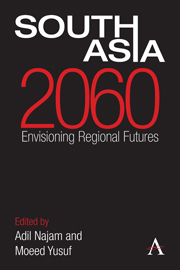Book contents
- Frontmatter
- Contents
- Acknowledgments
- List of Abbreviations
- Introduction: Imagining South Asian Futures
- Section I South Asia as a Region
- Section II State Relations
- Section III Development
- Chapter 16 South Asian Economy in 2060
- Chapter 17 Economic Futures: Challenges Ahead
- Chapter 18 South Asia in the Asian Economy: Struggling to Overcome History
- Chapter 19 Globalization and South Asia
- Chapter 20 Trade Relations: Some Predictions and Lessons
- Chapter 21 Urban Policy for Environmental Quality and Well-Being
- Chapter 22 Urban Futures, Urban Challenges
- Chapter 23 Water Security: Risks and Responses
- Chapter 24 Agriculture and Food Security
- Chapter 25 Meeting Electric Power Demand in South Asia
- Chapter 26 E-South Asia: A Social Science Fiction
- Section IV Human Well-Being
- About the Authors
- Bibliography
- Index
Chapter 26 - E-South Asia: A Social Science Fiction
from Section III - Development
Published online by Cambridge University Press: 05 September 2013
- Frontmatter
- Contents
- Acknowledgments
- List of Abbreviations
- Introduction: Imagining South Asian Futures
- Section I South Asia as a Region
- Section II State Relations
- Section III Development
- Chapter 16 South Asian Economy in 2060
- Chapter 17 Economic Futures: Challenges Ahead
- Chapter 18 South Asia in the Asian Economy: Struggling to Overcome History
- Chapter 19 Globalization and South Asia
- Chapter 20 Trade Relations: Some Predictions and Lessons
- Chapter 21 Urban Policy for Environmental Quality and Well-Being
- Chapter 22 Urban Futures, Urban Challenges
- Chapter 23 Water Security: Risks and Responses
- Chapter 24 Agriculture and Food Security
- Chapter 25 Meeting Electric Power Demand in South Asia
- Chapter 26 E-South Asia: A Social Science Fiction
- Section IV Human Well-Being
- About the Authors
- Bibliography
- Index
Summary
In the early twenty-first century, Indian firms controlled most of the undersea telecommunication cables in the world, yet Asia's ocean, the Indian Ocean, was the least well served by cables in the world. Unlike other continents, Asia also fell short on terrestrial connectivity. Bangladesh, then a nation of around 150 million people, got its first undersea cable connection in 2005 and took years to make full use of it. It connected to the world terrestrially only in 2012 when tensions with India were attenuated.
In the early twenty-first century, Asian telecommunication operators had to rely on undersea cables more than their counterparts did in Europe and in the Americas. Intra-Asian connectivity lagged, despite the vast size of the continent. For example, intra-Asian, lit-submarine cable capacity stood at 7 terabytes per second, about half the lit capacity on transatlantic routes, according to Telegeography Research. Like trade, most electronic communication occurred with places outside Asia. And trade over telecommunication links was only beginning. Where it existed, the bits ran mostly from Asia to Europe and North America, and little within the region. At the turn of the century, almost all Internet traffic went to or through the continental United States because that was where the servers were, and where even much Asian content was kept. But Asian traffic had started to shift away from North America by 2009 (Table 1).
- Type
- Chapter
- Information
- South Asia 2060Envisioning Regional Futures, pp. 201 - 208Publisher: Anthem PressPrint publication year: 2013



